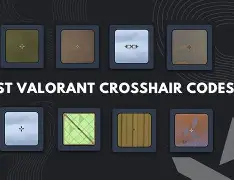One of the quickest ways to make your gameplay more consistent in Valorant is to decide on a crosshair. By using crosshair codes, you can quickly load the aiming points of the pros and the community, which have been tested, into your account. Then you can have a look in the practice range, and keep working until you find the sight that goes perfectly with your aim and playstyle. Since the meta and the pro preferences change quite often, the number of searches for “crosshair codes today” increases significantly when there are major tournaments, patches, or streamers changing their setups.
Where players find reliable crosshair codes today
Firstly, you have top crosshair databases and aggregator sites that gather pro and community submissions, allowing you to see the exact codes, get a preview, and then import them. There are daily updated, widely used community galleries and crosshair databases that thousands of players utilize as reliable sources for your next crosshair. Also, pro-player roundups and gaming outlets create regularly updated lists (for instance: pro picks, meta crosshairs, and region-specific favorites) besides publishing besides publishing of pro-player roundups and gaming outlets. These articles frequently come with the included direct copyable codes and brief agent or role indications that the crosshair is most suitable for.
Pro crosshair codes you can try today (examples & why they work)
Pro codes serve as a dependable starting point for you — pros are holding these reticles tests under heavy pressure of tournaments, so the selected ones are usually minimal in design, easily visible, and maintain their visibility when the map background changes.
The majority of the pro crosshair codes commonly circulated today are the ones employed by the players like TenZ, Zekken, and Sacy. Follow a pro code first and then adjust the thickness or the gap to match your monitor and your sensitivity.
How to import a crosshair code (quick steps)
- Launch Valorant and navigate to Settings → Crosshair.
- Click Import Profile Code under Crosshair Profiles.
- Put the full code string you have copied in the area provided and press Import.
- Check the crosshair at the practice range and change the opacity, thickness, or center dot if you like.
In all the recent client versions, this import process is the same, and it is very quick and safe to switch from one profile to another. If you are into manual tweaking, the crosshair editor is there for you to change each parameter (outline, inner/outer lines, movement/shot error options).
Today’s trending styles and when to use them
- Micro, stationary crosshairs: Typically used by players who rely heavily on the rifle and are able to keep their aim focus — the least possible visual distractions lead to better headshot accuracy.
- Medium thickness crosshair with center dot: Ideal for those players who at long distances need a clear point for aiming but at the same time they can do the close range fighting.
- Dynamic crosshairs (movement/shot error on): Great for learning the spray pattern of a gun but most of the pro players keep the dynamic features disabled for aim steadiness.
- High-contrast colors: Pick a color that will be very visible on the majority of the maps (but don’t pick colors that are already part of the major map textures). Test both light and dark backgrounds to be sure your crosshair is always visible.
How to pick the right crosshair for your playstyle
- Role & weapon – Duelists often prefer smaller crosshairs for flick accuracy; controllers and anchors may favor slightly larger reticles for clearer tracking.
- Monitor size & resolution – A setting that works on a 24″ 1080p monitor may feel tiny on a 1440p or 240Hz display – scale thickness/gap accordingly.
- Test for 30-60 minutes – Try a candidate crosshair in deathmatch and aim trainers; don’t judge after a single game.
- Comfort beats trend – Popular crosshairs aren’t guaranteed to improve you – consistency is what matters.
Pro tips for importing and adapting codes quickly
- Have a bank of crosshair profiles ready: Keep saved different profiles for various agents or playstyles that you use.
- Copying the exact codes from the reliable sources: Get the codes from the well-supported sources like databases and pro roundups instead of random forum posts.
- Modifying by map lighting: Suppose you play the same map four times a week, then tweak the color or outline to get the better contrast of that map.
- After importing spend some time on aim maps or third-party trainers to see real improvement.Use aim trainers
Common mistakes players make (and how to avoid them)
- Without the testing blindly copying – the crosshair of a pro may be suitable for their sensitivity or display but not for you. Always test.
- Mistaking the crosshair for being too small – at too many lines, outlines, or center dots the targets at distances can be hidden.
- Disregarding movement/shot error settings – these can affect the behavior significantly; most high-level players have these settings turned off.
Where crosshair trends come from (why “today” changes)
One reason for the changes in crosshair trends is when the top-tier players change their settings. Other reasons include meta role changes, high-profile creators publishing new setups. Usually, big tournaments and streamer endorsements are the main factors that lead to the rapid adoption of specific codes. One can easily find out what is currently trending by looking at the freshly updated aggregator galleries and pro-roundup articles.
Closing — test, iterate, and make it yours
Crosshair codes are a strong weapon when used correctly because they allow you to copy the setups of the elites immediately. However, the quickest way to get better is to import, test, tweak, and practice. Consider today’s curated codes as your first layer, and then fine-tune the parameters until your reticle becomes an invisible extension of your crosshair muscle memory.
Also Read: Coinbase Slams Banks for Pushing to Ban Stablecoin Merchant Rewards, Calling It “Un-American”
